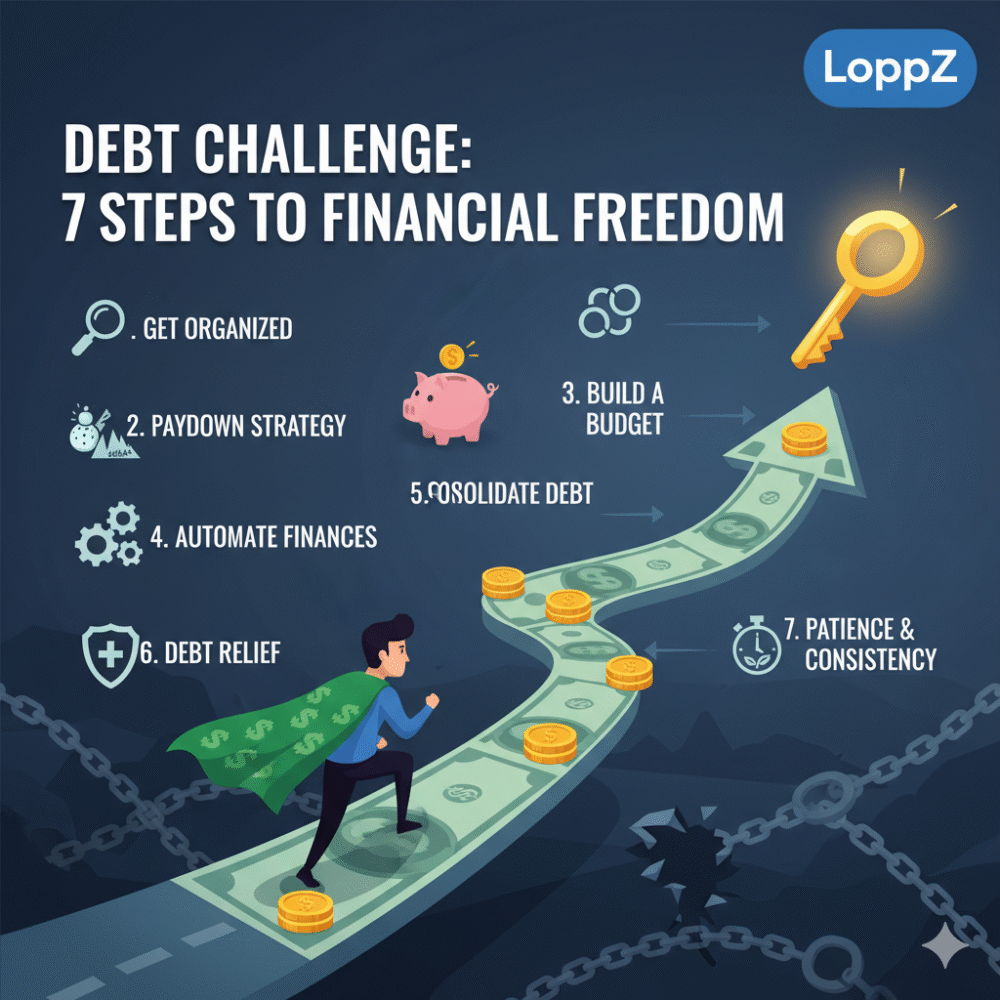Introduction: Facing the Debt Challenge
Achieving debt freedom 2025 with LoppZ. Follow our proven 7-step plan to eliminate debt, reduce stress, and build lasting financial control.
6 out of 10 Americans say that money is a “significant form of stress”. 80% of Americans have debt, and 13% of these people will live in debt for the rest of their lives.
Most of us have been there, not enough money and too many bills, but don’t let that defeat you. You can take control of your debt and relieve some of the stress, shame, and anxiety that being in debt can cause.
In this post, you always have two options when it comes to debt. You can ignore it, let it linger and consume your finances, and potentially have it negatively affect your health.
Or you can rise to the challenge, take control, and get rid of it. If you’re looking for a better way to control your debt; to eliminate most if not all of it, then here are a few steps you can do.
1. Get Organized
For many people, it can be one of the most difficult stages. It can be heavy and lowly terrible, but to take control, you have to be honest with yourself and you have to face your numbers.
You have to assess your financial situation by gathering all the information surrounding your debts. Financial experts have advised that denial is one of the largest stress coping mechanisms people use, but this can cut a destructive path in your financial life.
Ignoring your debt will not make it go way. Instead, much like managing your money, you have to be organized as it can be revealing to see where you’re spending your money.
A good way to do this is to make a clear list of your numbers, to see where and how much you are outstanding. Start by listing all your credit cards, store cards, loans and other loans.
Include creditors, total loan amount, monthly payment, interest rates and fixed dates.Once you know how much you owe and to whom, you’ll be better placed to sort your debts.
- You can look at your credit report to help confirm these numbers. Facing your numbers will allow you to see the bigger and complete picture.
- And will help you be more informed to create a plan of attack. When you see these numbers, you can then make adjustments.
2. Pay Down Strategy
Now you’ve seen the numbers and let’s be honest, it probably sucks. And yeah! A lot of the time it’s that way until you take control.
What you want to do next is to plan your paydown strategy. It will help you get ahead faster. There are many different pedown strategies that you can use, but two of the two most famous people are snowball method and avalanche method.
- With the snowball method, you focus on paying your smallest loans first, regardless of the interest rate, regardless of the minimum payments on all other loans.
From there you progress gradually by knocking out the smaller debt and working toward the bigger ones. Many people like this method because although you may potentially pay more over the long term, you may see and be motivated by progress faster.
With the Avalanche method, you attack your debt based on the amount that has the highest interest rate. Mathematically, this typically means you’ll pay less money overall as you’d be attacking the debt that’s accruing the most money, but it could also mean you see less progress initially, which for some, may cause motivation to lag.
- Regardless of which method you choose, stick to it, and attack.
3. Build A Budget
A budget plan will help keep you on track so you don’t squander away your earnings, and helps focus your efforts towards your debts. Whatever strategy you choose, you need a plan for focus and direction.
With careful planning over time, you can execute and control your debt. The budget helps you track and monitor your spending habits. Some of these may be habits that put you in debt in the first place, so this is a good opportunity to use your money, where you use your money.
It will help you avoid bad debt by living below your means. A well-formulated budget can help you get on track with your money and your debts and help you to stay focused.
A budget can help you manage expenses and put away more money toward your debts. It could show you that packing your lunch instead of eating out and keeping your phone rather than changing it for the latest model can help you use that money toward getting out of your debt faster.
Within this planning area, it’s also important to set aside an emergency fund. This way you don’t turn to credit again when an emergency comes up.
- Protect yourself by saving up a base.
4. Automate Finances
As much as you plan these things, it’s better not to rely on your will or discipline for the execution. Even the most disciplined people make mistakes.
One way to help you be more effective in your debt management and control is to set up an automated execution plan. You make the plan and set up systems to help you execute those plans. This will reduce temptations and mistakes on your path.
If you’re saving for your emergency fund, have money automatically sent into a completely separate account. If there’s a particular bill that comes up irregularly, set up an automatic payment so that you don’t forget.
When you automate your debt management you never have to worry about on-time payments. Payments are processed automatically even when you forget. This can reduce fees, help your cash flow, and can allow you more time to plan.
Automated payments are more cost-effective when compared with the usual paper transactions.
- This reduces errors, duplicate payments, and overpayments. This is also one less thing on your list, giving you more time for more enjoyable tasks.
5. Consolidate Debt
Another option you have to take control of your debt is to roll all your debts (credit card bills, student loans, or other loan payments) into one loan or monthly payment. This is called debt consolidation. It simplifies and potentially lowers your payments.
Debt consolidation allows you to combine high-onion loans in a loan with low interest rate.Understand that with a safe loan you have to keep the collateral down like a car or house.This could help you have one payment to focus on. Doing this can help save you money on interest and allow you to track your debt repayment better as you now have just one monthly payment.
You can also consider refinancing your debt. What this means is, you replace existing debts with another debt that has more favorable terms. You would take out a new loan that would pay off the old debt and give you updated agreements.
Transferring credit card balances to take advantage of low introductory or promotional interest rates is one way to do this. You can decide to transfer all your credit cards to a low-interest rate card and handle your debt better as you save on interest. Just keep in mind that transfer fees may be applicable.
Secured or unsecured loans is another option. Understand that with a secured loan you’ll need to put down collateral, like a car or home.
- But such a loan usually comes with a long deadline to repay in high amounts, low interest rates and an unsafe loan.
Before consolidating or refinating your debt, we highly suggest that you talk with a financial professional so that you are aware of how it can potentially affect your financial health.
6. Debt Relief Services
If you find that consolidation or refinancing doesn’t work for you or you have a lower credit score, you can consider using a debt relief service or credit counseling. These nonprofit organizations are there to help you end the perpetual debt cycle.
Some are free, others may charge a low monthly fee. They will negotiate with your creditor on your behalf. Usually, credit counselors will also work with you to set up a budget and provide you with materials to help improve your money management habits.
7. Patience And Consistency
Debt can seem uncontrollable and a frightening prospect especially when it’s compounded over time. With patience, responsibility, and consistent deliberate actions, you can manage even outstanding overdue balances.
With consistency, even small efforts will yield great results over time. You have to understand that the seemingly small mundane efforts can move you massively towards having a better standing with your debts. You just have to be patient while committing to changing and handling your debts better.
Having total control of your debt won’t happen in a day or two. You have to be consistent in your effort, but you can manage your debt and not let it manage you.
That’s it for this post. Thanks so much for reading. If you find this post interesting or helpful, we would like to hear from you.









